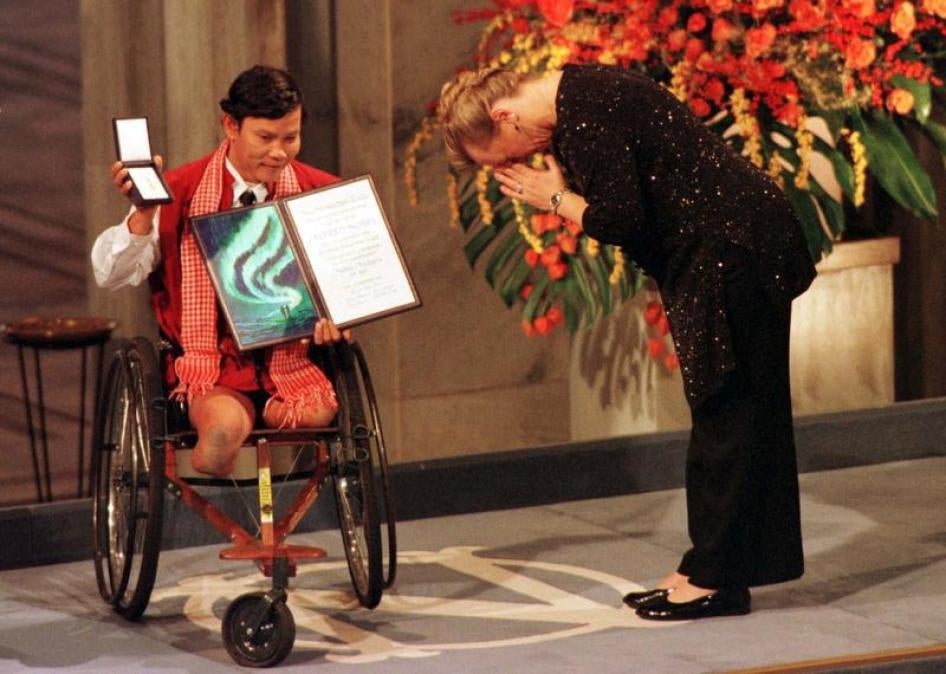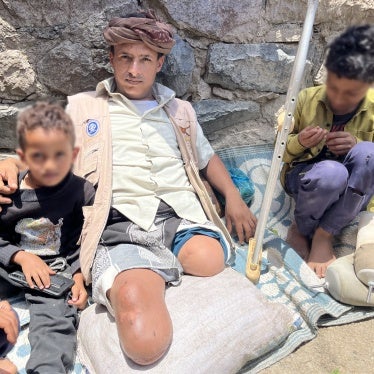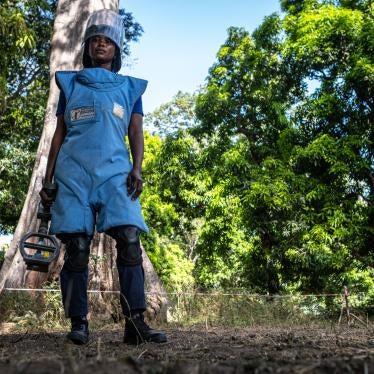This year marks 25 years since an international ban on antipersonnel landmines came into force, an achievement for which Human Rights Watch shared the 1997 Nobel Peace Prize as a founding member of the International Campaign to Ban Landmines (ICBL).
Jody Williams, the group’s coordinator, also received the 1997 award for what the Nobel Prize Committee described as transforming “a ban on anti-personnel mines from a vision to a feasible reality.”
Steve Goose, arms campaigns director of the Crisis, Conflict, and Arms Division at Human Rights Watch, was in Ottawa, Canada, to witness the signing of the Mine Ban Treaty by representatives of 122 countries.
Antipersonnel mines are explosive devices that kill and injure people both during and long after conflicts. They cannot distinguish between a soldier and a civilian. Landmines pose an ongoing danger until they are cleared and destroyed. Mined land can force civilians to leave the area and make farming or delivering humanitarian aid especially dangerous.
Antipersonnel mines had been widely used since the Second World War, creating a humanitarian catastrophe. By the time the treaty was negotiated in 1997, about 55 countries had manufactured antipersonnel mines, creating stockpiles numbering in the hundreds of millions. To deliver a ban on such a widely used weapon was a landmark achievement that has since saved thousands of people from death or injury.
The treaty prohibits any use, production, stockpiling, and transfers of antipersonnel landmines. It requires member countries to destroy their stockpiles, clear mine-affected land, and help victims. Since the Mine Ban Treaty entered into force on March 1, 1999, more countries have joined, pushing the total number to 164.
The Mine Ban Treaty was groundbreaking not only for delivering the very first ban on a weapon that was in widespread use but also for the unique way in which it was negotiated.
Instead of agreeing by consensus, changes to the draft treaty text required approval from a majority of the participating countries, by a vote if necessary. This meant that countries like the United States needed broad support for its efforts to insert loopholes, reservations, and exceptions into the draft treaty. Ultimately, the US did not succeed, withdrew the proposals, and never signed the treaty.
Countries most impacted by landmines, such as Cambodia, Mozambique, Angola, and Croatia, played a leadership role in the negotiations, as did small and medium sized states, such as Austria, Belgium, Philippines, and South Africa. “There was no way these countries were going to compromise,” said Mary Wareham, deputy Crisis, Conflict and Arms director at Human Rights Watch. “That’s why they call multilateralism the great leveller. It was one country, one vote. We fought for the strongest possible treaty because generally you don’t go back and fix treaties after they’re adopted.”
For Human Rights Watch and other cofounders of the ICBL, the journey began in the late 1980s as the Cold War was coming to an end and the scale of the devastation caused by landmine use was beginning to be recognized. In 1986, Human Rights Watch published its first report on the issue, entitled “Landmines in El Salvador and Nicaragua: The Civilian Victims.” And in 1991, together with Physicians for Human Rights, it released “The Cowards War: Landmines in Cambodia.”
After working as a senior staff member in the US Congress, Goose joined Human Rights Watch’s Arms Division in 1993, months after it was established. His first assignment was to draft “Landmines: A Deadly Legacy,” a report that would become the go-to reference book for diplomats, officials, and activists working to achieve a ban on antipersonnel mines. Goose would go on to play a central role in the treaty negotiations, working alongside Wareham, who was then with the ICBL. Wareham joined Human Rights Watch in 1998 to help establish Landmine Monitor, an ICBL initiative to systematically assess and monitor countries adherence to the Mine Ban Treaty’s provisions.
Human Rights Watch hosted the inaugural meeting of the campaign in its New York office in October 1992. The Vietnam Veterans of America Foundation joined Human Rights Watch, Handicap International (now known as Humanity and Inclusion), Medico International, Mines Advisory Group (MAG), and Physicians for Human Rights as the founding members of the organization.
Currently, the ICBL has members in dozens of countries working across areas as diverse as human rights, humanitarian response, women’s rights, and religion – its achievements have been enormous. Since the signing of the Mine Ban Treaty, the number of countries producing landmines has dropped to a dozen; annual casualties from landmines have fallen dramatically from more than 25,000 per year to approximately 5,000 annually; more than 55 million antipersonnel mines have been destroyed from stockpiles; and 30 previously mined countries have completed clearance and been declared mine free.
But despite these successes, important challenges still exist. That’s why Human Rights Watch continues to carry out advocacy and research on the issue and contribute to the ICBL.
The Landmine Monitor 2023 report lists Myanmar, Syria, Russia, and Ukraine as key countries of concern when it comes to new use of antipersonnel landmines. Russian forces have used antipersonnel landmines extensively since their full-scale invasion of Ukraine in February 2022, resulting in a massive increase in the number of casualties from landmine and explosive remnants of war. Ukraine has joined the Mine Ban Treaty, the others have not.
Ukrainian forces have also used antipersonnel mines, causing civilian harm. Human Rights Watch was the first organization to document that Ukrainian forces had used rocket-fired antipersonnel mines in and around the city of Izium in 2022, when the city was occupied by Russian forces. Additional evidence of landmine use by Ukrainian forces was published in June 2023.
At a meeting of the Mine Ban Treaty in June, Ukraine announced it had opened a “pretrial criminal investigation” into the reported use of antipersonnel mines. Its representatives met with Goose to explain the steps being taken to investigate.
“Ukraine is a serious situation because it's a state party to the Mine Ban Treaty and has committed to never use antipersonnel mines under any circumstances,” Wareham said.
The treaty’s Fifth Review Conference will be held in Siem Reap, Cambodia at the end of November. The high-level meeting only takes place once every five years, and it is expected to attract political leaders from several countries.
Fittingly, the conference is being held in Cambodia, a mine-affected country that has played a pivotal role in efforts to eradicate these devastating and indiscriminate weapons.
It’s “a big moment for Cambodia,” said Wareham. “There has been incredible progress in clearing mines from around towns and cities, and it now takes hours to reach more remote areas affected by uncleared landmines. Cambodia is keen to use this opportunity to demonstrate the progress it has made.”
The Review Conference is an important opportunity to review the Mine Ban Treaty’s progress and to consider how to convince more countries to support the ban. The last countries to join the treaty were Sri Lanka and the State of Palestine in 2017. China, India, Russia, and other non-signatories have made little effort to join. In June 2022, President Joe Biden set the US the goal of ultimately joining the Mine Ban Treaty and realigned US policy so that it aligned with most of the treaty’s core prohibitions. However, since then the US has made little progress toward joining.
“The treaty’s ultimate goal is to put an end to the suffering and casualties caused by antipersonnel mines,” Wareham said. “The treaty provides the best framework to help us get there. By staying focused on this goal and collaborating with partners, we will continue to make progress, reducing the terrible toll wrought by antipersonnel mines.”










